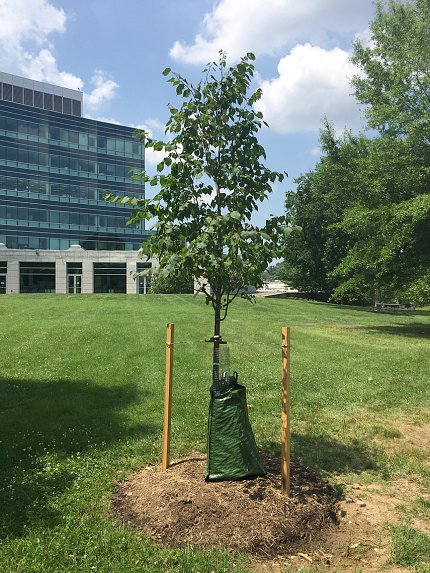Fortifying NIH’s ‘Forests’
Tree Population Grows on Campus

Photo: Brandon Hartz
If a tree falls in the forest and nobody is around to hear it…Brandon Hartz will surely replace it in due time. At least that’s how it works on NIH’s Bethesda campus. The agency’s landscape architect has been busier than usual over the past year or so, overseeing the planting of more than 200 new trees since spring 2017.
“We’ve lost—due to old age, storm damage and safety concerns—a lot of trees,” Hartz reported recently. In 2016, 198 trees were lost; in 2017, the campus lost 125 trees.
On its 300-acre Bethesda campus, NIH has about 8,500 trees (of at least 2 inches dbh, or diameter at breast height—a standard arboreal measuring unit). The Forest Conservation Plan that the agency maintains with the state of Maryland requires one-to-one replacement. Every time we lose a tree, we have to plant one to take its place.
With funding help from the Office of Research Facilities’ Division of Environmental Protection, Hartz authorized 128 trees to be planted last fall. That’s in addition to the 70 plantings completed during spring 2017. A contractor team handles the considerable manual labor required to sink new trees into soil, but strategizing where and what to plant is Hartz’s purview.
His goal was to enhance wooded areas that could reasonably become official “forests.” By Maryland’s definition, a forest has 100 trees (of 2 inches dbh) growing per acre. Only 1 percent of NIH land meets the standard.
Hartz targeted 20 native tree species for existing “forests with enhancement needs”—the official designation that most of NIH’s wooded areas qualify for.
New trees have been placed along NIH’s southern border, near parking lot 41 in the buffer area with the Whitehall condominiums, behind the Gateway Center on Rockville Pike, along Wilson Drive coming onto campus, west of Bldg. 31 where the 15 Quarters homes sit within the perimeter fence and behind the multi-level parking lots.
“The tricky thing about planting in an existing forest is that it’s not like starting a new forest, where a tree is going to have as much light and water as you can give it,” Hartz explained. “A young tree’s got to be able to survive underneath an existing tree canopy. So we focused on plants that can grow well near trees with understory [shorter vegetation living beneath overhanging branches]—dogwoods, redbuds, witch hazels. These are trees that can grow tall, but also can live in shaded conditions—beech trees and American holly, which is an evergreen that will live in the shade.”
This past spring, Hartz said, crews began to replace trees that were lost along roads and shaded walkways or ones that had important screening purposes toward the center of campus. He’s also sprinkled a few tree lilacs in select locations. Tree lilacs are salt-tolerant—a welcome attribute for trees located near pathways affected by snow- and ice-clearing.
“We try to replant native trees that are known to grow in this area,” he said. Sometimes, however, that’s not fruitful.
“Behind Natcher, we have a lot of compacted soil,” Hartz noted, “and not a lot of trees like to live in compacted soil because the water tends to stagnate and there’s not a lot of oxygen available to the roots. It’s quite common in heavily used space where foot traffic and vehicles squeeze soil particles together.”
In that area and several other regions that are proving difficult to reforest, Hartz has had to experiment a bit to find what might work. Recently he’s put in a gingko and three little-leaf lindens on Bldg. 45’s back lawn, hoping they’ll take.
“Ashes do well in the compacted soil,” he said, “but they are also susceptible to the deadly emerald ash borer beetle.”
Hartz said the most important aspect of successful planting is getting young trees firmly established. Employees can easily identify newly planted trees by their appearance: Most are wired to wooden stakes that help keep the trunk stable so roots can grow. Green slow-release watering bags may be affixed to trunks as well, so newbies get the crucial moisture they need in their early stages. Finally, many are also encased in metal mesh columns.
“That’s to protect from deer,” Hartz explained. “The young bucks like to scrub the velvet off of their antlers by rubbing against tree trunks. In the process, they also scrape away the tree’s bark, exposing all of the living tissue.” Deer can cause irreparable injury, especially to young trees.
Whatever befalls the trees on campus, Hartz will document their most important moments in the database he maintains. The searchable survey notes the location of all trees on campus and each live plant has both a metal number tag and a corresponding digital tree that can be tracked down on screen.
“I don’t keep track of routine growth and the minor issues for each tree,” he concluded, “but when something critical happens—like a lightning strike or rotting limbs—I update the database and I can immediately locate trees in trouble.”
